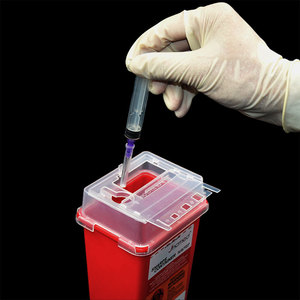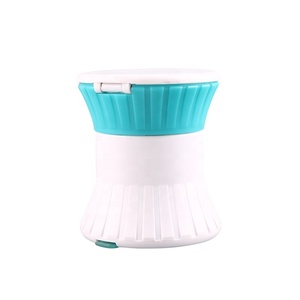(518 products available)














































































































































































































































Medical sharps waste containers are highly specialized receptacles designed for the safe disposal of sharps waste in a medical setting. "Sharps" refers to any medical waste that can puncture or cut the skin and cause injury or infection. This category includes used needles, scalpel blades, broken glass, and any other sharp instruments. These containers are critical in hospitals, clinics, and laboratories for maintaining safety and preventing accidental injuries or exposure to bloodborne pathogens.
Typically made from durable materials like polypropylene, medical sharps waste containers are built to withstand the rigors of healthcare environments. They are characterized by their puncture-resistant properties, secure lid mechanisms, and often, features like foot pedals for hands-free operation. Containers are designed to be used in a variety of settings, from large hospitals to small clinics, thus catering to different scales of operation. They are often color-coded and labeled to ensure easy identification and compliance with waste segregation protocols.
There are several types of medical sharps waste containers, each designed to cater to a specific need within the healthcare industry. From small, portable containers for individual use to large, stationary units for hospital waste management, these receptacles ensure the safe disposal of hazardous materials across all medical settings.
Standard medical sharps waste containers
Standard medical sharps waste containers are primarily designed for the disposal of sharp objects. These containers are constructed from hard plastic and are puncture-proof, ensuring that used needles and other sharp medical instruments cannot pierce through the sides. They typically come with lids that can be secured to prevent any accidental openings. Standard containers are available in different sizes, which can be chosen based on the needs.
Wall-mounted medical sharps waste containers
Wall-mounted medical sharps waste containers are designed to be affixed to a wall, which helps to save space and keep the container at an easily accessible height. These containers are particularly useful for areas where floor space is limited or where it is necessary to keep the container out of reach from the ground for safety reasons. Like standard containers, wall-mounted versions are also puncture-resistant and come with secure lids.
Floor-standing medical sharps waste containers
Floor-standing medical sharps waste containers are larger and are designed to be placed on the ground. These containers can hold a considerable amount of waste, making them suitable for areas with high traffic or where a large number of sharp objects are used. Floor-standing containers also have foot pedals that allow for hands-free operation, further ensuring that the container can be closed without having to use hands.
Biohazard medical sharps waste containers
Biohazard medical sharps waste containers are specifically marked with biohazard symbols to indicate that they contain materials potentially infectious and therefore pose a risk to health and safety. These containers are typically used for the disposal of sharps that may be contaminated with blood or other bodily fluids. Like standard containers, biohazard containers are also puncture-proof and come with tight-fitting lids.
Needle stick prevention devices
Needle stick prevention devices are specialized containers designed to prevent needle stick injuries when disposing of needles. These devices often have features that allow for the safe and secure disposal of needles without the risk of hands coming into contact with the sharp end of the needle.
Colour Coding:
Containers for medical sharp waste are usually color-coded. These colors help identify what kind of waste a container holds. For example, red containers hold biohazard waste, green ones hold recyclable sharps, and yellow ones hold infectious waste. These colors make it easier for medical workers to sort waste correctly and safely.
Materials Used:
Medical sharp waste containers are made from strong, durable materials. Most are made from plastic or metal. The materials need to be tough so that containers can handle sharp objects without breaking. This prevents needles and blades from puncturing the outside and potentially causing harm. The insides may also have features like baffles or locking mechanisms to keep sharp objects from moving around or getting out even if the container is tipped over or dropped.
Shape and Size Options:
Containers come in different shapes and sizes for various uses. Some are rectangular boxes that can sit on tables or floors. Others are round or cylindrical, like large jugs. Smaller containers may look like bottles with narrow openings that could fit in pockets or belts. This variety allows medical workers to choose the best container for their needs depending on how much waste they need to dispose of and where they are using it. No matter the shape or size, all containers should be able to collect sharps safely without overflowing or leaking.
Security Features:
Medical sharp waste containers have features that keep them secure when not being used so that no one can come into contact with hazardous materials inside. This is important for public safety and environmental protection. Containers often have lids that lock or seal tightly. Some may even have foot pedals that allow users to open the top without using their hands, keeping them clean and preventing unwanted access from other people nearby. These security features help ensure that potentially dangerous used needles and blades cannot be reached by anyone except authorized personnel who need to throw them away.
Medical sharps containers are used in many industries where sharp objects can harm people. They work as a safety measure, helping to keep people safe from dangerous injuries and infections. These containers are crucial in the following industries:
Regulatory Compliance
When selecting sharps containers for sale, it is critical to ensure that they comply with local and national regulations. These regulations often outline specific requirements for the design, labeling, and performance of sharps containers. By choosing containers that adhere to these regulations, healthcare facilities can maintain compliance and uphold the highest standards of safety and waste management.
Type of Healthcare Facility
The type of healthcare facility plays a significant role in determining the appropriate sharps containers. Different healthcare settings generate varying volumes and types of sharps waste. For instance, hospitals may require large-capacity containers due to high waste volumes, while outpatient clinics might opt for smaller, more portable containers. Considering the specific needs of the healthcare facility ensures that the sharps containers are practical and effective.
Container Design and Features
Several important design features should be considered when choosing a medical sharps waste container. First, the containers should have a puncture-resistant construction material that can withstand the sharp objects without risk of rupture. Second, they should have a secure, one-way opening that allows used sharps to be deposited but prevents retrieval. Third, stackability and portability enhance ease of use and transportation within healthcare facilities.
Capacity and Volume
The capacity and volume of the sharps container are critical considerations. Healthcare facilities must select containers with sufficient capacity to accommodate the expected sharps waste volume. If the containers are too small, they may fill up quickly, leading to overfilling and potential safety hazards. On the other hand, excessively large containers may be impractical and waste space. Striking the right balance ensures the containers remain safe and convenient.
Cost and Budget
The cost of sharps containers is an important consideration for healthcare facilities. Facilities must evaluate the initial purchase price and the long-term costs associated with container disposal and replacement. Opting for cost-effective containers does not compromise safety and quality. However, facilities should avoid prioritizing cost over quality, as this could jeopardize the effectiveness of sharps waste management.
Q1: Why is it important to use a needle disposal container?
A1: It is vital to utilize a sharps container to reduce the danger of needle-stick wounds and disease transmission. These receptacles are intended to hold needles and other sharp clinical waste safely until they can be discarded appropriately.
Q2: What are the characteristics of an effective sharps container?
A2: Durable plastic that can withstand punctures and overflowing is among the characteristics of a good sharps container. It should have a tight-fitting cover that, once shut, cannot be opened without breaking and should be capable of being secured in a manner that permits disposal of the contents without exposing them.
Q3: What kind of sharps containers do hospitals use?
A3: Hospitals utilize different kinds of sharps containers to securely discard needles and other sharp clinical waste. These receptacles are intended to forestall needle-stick wounds and cross-tainting. Hospitals typically use receptacles that are red and have a high limit for gathering clinical waste.
Q4: What is the purpose of red bags in hospitals?
A4: The red bags in hospitals are utilized for the protected and appropriate removal of clinical waste, like sharps and biohazardous materials. These sacks are intended to recognize perilous waste that requires uncommon treatment to forestall pollution or injury.
Q5: How can one tell if a sharps container is full?
A5: Many sharps receptacles have a fill line or indicator that becomes visible when the container is full. It is vital to check these markers often, as overfilled receptacles can present a security risk.